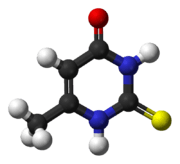Methylthiouracil
 | |
|---|---|
 | |
| Systematic (IUPAC) name | |
| 6-methyl-2-thioxo-2,3-dihydropyrimidin-4(1H)-one | |
| Clinical data | |
| AHFS/Drugs.com | International Drug Names |
| Legal status | ? |
| Identifiers | |
| CAS number | 56-04-2 |
| ATC code | H03BA01 |
| PubChem | CID 667493 |
| UNII | QW24888U5F |
| KEGG | C19265 |
| Chemical data | |
| Formula | C5H6N2OS |
| Mol. mass | 142.18 g/mol |
| | |
Methylthiouracil is an antithyroid preparation. It is a thioamide, closely related to propylthiouracil.
Methylthiouracil is not used clinically in the United States, it has a similar mechanism of action and side effect to that of propylthiouricil.
The drug acts to decrease the formation of stored thyroid hormone, as thyroglobulin in the thyroid gland.
The clinical effects of the drug to treat the hyperthyroid state can have a lag period of up to two weeks, depending on the stores of thyroglobulin and other factors.
Side effects
Like with any drug a wide variety of side effects can occur, but four topics should be kept in mind and the patient informed:
Agranulocytosis - develops rapidly, sore throat and fever are hallmark symptoms. Can be fatal if drug is not discontinued promptly.
Allergic skin reactions the most dangerous of which is Exfoliative Dermatitis, it rapidly can get out of control, notify the physician should a skin eruption occur.
Hepatitis - yellowing of the skin, nausea, yellowing of the whites of the eyes, flu-like symptoms.
Thrombocytopenia - unusual bruising or bleeding.
External links
see link on discussion of Hyperthyrodism: http://www.merck.com/mmpe/sec12/ch152/ch152e.html#S12_CH152_T002
| |||||||||||||||||||||||||||